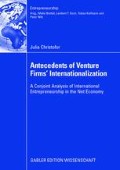Abstract
The definition of ‘internationalization’ according to Welch and Luostarinen (1988) is the process of business activities across home country borders with an increasing degree in operations8. While the term ‘international business activity’ implies the exchange of resources across national borders (Fayerweather, 1978), the ‘internationalization process’ is traditionally perceived as the consequence of incremental adjustments to changing conditions within the firm and its environment (Aharoni, 1966). Most significantly, Perlmutter (1969) already then acknowledged the conjunction of internationalization and attitudinal development within the firm, indicating the impact of the company expansion across borders on an organization.
Access this chapter
Tax calculation will be finalised at checkout
Purchases are for personal use only
Preview
Unable to display preview. Download preview PDF.
References
The term internationalization is applied when referring to country, industry or firm-level issues (Dana et al., 2004). Globalization, on the other hand, is according to the World Trade Organization (WTO) only used on a country or industry level and describes the macroeconomic and cross-national continuous integration of the world economy.
Market entry strategies are largely discussed in the international management literature, however, the question of choosing a market to process is also a dominant topic in the international marketing literature (Meffert and Bolz, 1998).
For an insight into the role the foreign subsidiaries of international corporations can have on the technological development of the host country see Berger (2006).
Different classifications of risks in international business activity can be found in the literature. For empirical evidence on risks in the international competitive arena cf. Tan (1996) and Brouthers (1995).
A foreign direct investment is an “investment by one firm in another with the intention of gaining a degree of control over that firm’s operation” (Dicken, 2003, p. 51).
For a deeper insight into the environmental influencing factors, especially the micro-and macroeconomic environment of internationalization decisions cf. Dülfer (2001) and chapter 2.1.1.
For a recent study on the knowledge transfer between international joint venture or alliance partners see Klijn (2006).
For an overview and the development of the theories applied to the international entrepreneurship field consult Dana et al. (2004).
Meckl and Schramm (2005, p. 15) suggest that transaction cost economics and the Uppsala model of internationalisation are the two most influential schools of internationalisation.
For a comprehensive literature review and discussion of the process models see Leonidou and Katsikeas (1996) and Ellis and Pecotich (1998).
In addition, the incremental internationalization approach was also taken up in the diversification literature (Chandler, 1986; Vernon, 1979).
The terms local, national, international, multinational and global were defined by Perlmutter (1969) and refer to the breadth of the geographic dispersion of an firm.
E-Ventures are believed to be similar to service firms in their internationalization behavior because of mutual product and firm characteristics (Ekeledo and Sivakumar, 2004).
The term ‘marketspace’ was coined by Negroponte (1995); cf. introductory remarks.
According to Miesenbock (1988, p. 173) it is the most prominent model because it has since received widespread attention in the literature. For example, Cavusgil (1980, 1982) also bases his model on increasing export activities, and on a push mechanism from the external environment.
Rights and permissions
Copyright information
© 2008 Gabler | GWV Fachverlage GmbH, Wiesbaden
About this chapter
Cite this chapter
(2008). Theoretical Foundations of Firm Internationalization. In: Antecedents of Venture Firms’ Internationalization. Gabler. https://doi.org/10.1007/978-3-8349-9821-7_2
Download citation
DOI: https://doi.org/10.1007/978-3-8349-9821-7_2
Publisher Name: Gabler
Print ISBN: 978-3-8349-1115-5
Online ISBN: 978-3-8349-9821-7
eBook Packages: Business and EconomicsBusiness and Management (R0)

